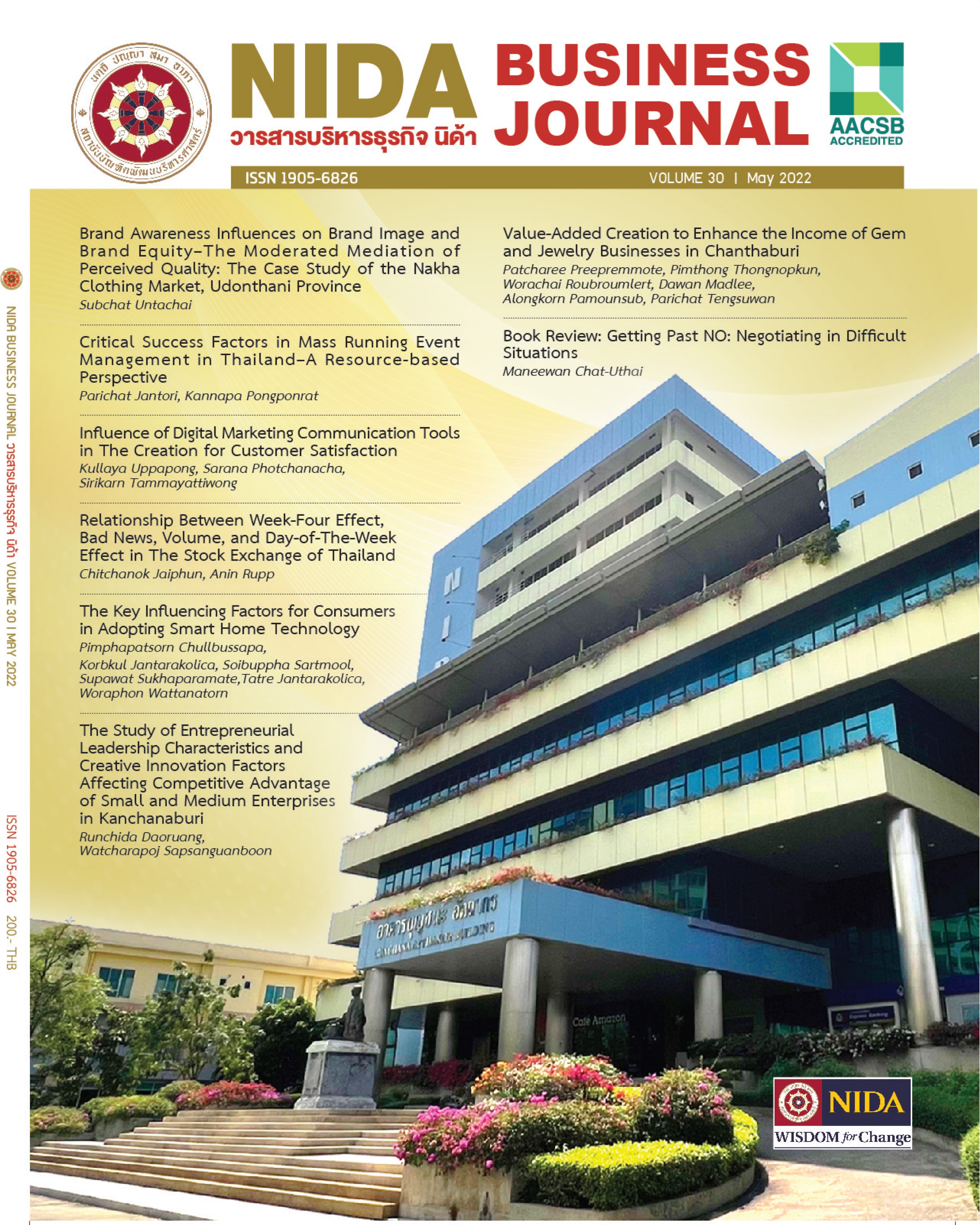ปัจจัยที่ส่งผลต่อความสำเร็จในการจัดงานวิ่งในประเทศไทย– มุมมองบนพื้นฐานทรัพยากร
คำสำคัญ:
ปัจจัยที่ส่งผลต่อความสำเร็จ, กีฬามวลชน, ิกิจกรรมวิ่งมาราธอน, มุมมองทรัพยากรพื้นฐานบทคัดย่อ
กระแสนิยมการวิ่งเป็นหนึ่งในปรากฏการณ์ทางสังคมที่เกิดขึ้นในหลายๆ ประเทศทั่วโลก รวมถึงประเทศไทย แต่ งานวิจัยในด้านนี้ยังมีจำนวนจำกัด การศึกษาชิ้นนี้จึงมีวัตถุประสงค์เพื่อศึกษาปัจจัยที่ส่งผลต่อความสำเร็จในการจัดงานวิ่ง โดยใช้แนวคิดพื้นฐานทรัพยากรและส่วนต่อขยายของแนวคิดนี้เป็นทฤษฎีพื้นฐานในการศึกษา และอาศัยการเก็บข้อมูล เชิงคุณภาพด้วยการสัมภาษณ์ผู้จัดงานวิ่ง ผู้อำนวยการงานวิ่งในประเทศไทย และใช้วิธีวิเคราะห์เนื้อหาเชิงคุณภาพในการ วิเคราะห์ข้อมูล
ผลการศึกษาพบว่า ทรัพยากรที่จับต้องได้และจับต้องไม่ได้ เช่น สถานที่ เงินทุน ชื่อเสียงของผู้จัดงานและชื่อเสียง ของงานวิ่งที่สั่งสมมา ตลอดจนความสามารถเชิงพลวัตและความสัมพันธ์ ล้วนเป็นทรัพยากรที่มีบทบาทสำคัญในการส่งเสริม ความสำเร็จ และสร้างความแตกต่างให้เกิดขึ้นระหว่างงานวิ่งชั้นนำและงานวิ่งทั่วไป อย่างไรก็ดี การศึกษานี้ไม่ครอบคลุมการ วิเคราะห์บทบาทของผู้จัดการอีเวนต์หรือผู้อำนวยการงานวิ่ง รวมถึงเป็นการนำเสนอปัจจัยที่ส่งผลต่อความสำเร็จจากมุมมอง ของผู้จัดงานวิ่งหรือผู้ให้บริการ งานวิจัยในอนาคตสามารถเพิ่มการศึกษาบทบาทของผู้จัดการอีเวนต์หรือผู้อำนวยการงานวิ่ง รวมถึงวิเคราะห์ปัจจัยที่ส่งผลต่อความสำเร็จของการจัดงานวิ่งจากมุมมองด้านอุปสงค์ หรือมุมมองของผู้เข้าร่วมกิจกรรม
References
Barney, J. B. 1991. “Firm resources and sustained competitive advantage.” Journal of Management, 17: 99-120.
Barney, J. & Arikan, A. 2001. “The resource-based view: Origins and implications.” In M. Hitt, R. Freeman, & J. Harrison (Eds.). “Handbook of strategic management.” Oxford, UK: Blackwell.
Bromiley, P. & Rau, D. 2016. “Operations management and the resource based view: Another view.” Journal of Operations Management, 41(2016): 95-106.
D’Oria, L., Crook, T. R., Ketchen, D. J., Sirmon, D. & Wright, M. 2021. “The evolution of resource-based inquiry: A review and meta-analytic integration of the strategic resources–actions–performance pathway.” Journal of Management, 47: 1383-1429.
Green, B. C. 2005. “Building sport programs to optimize athlete recruitment, retention, and transition: Toward a normative theory of sport development.” Journal of Sport Management, 19: 233-253.
Jaafar, M. & Abdul-Aziz, M. 2005. “Resource-Based View and Critical Success Factors: A Study on Small and Medium Sized Contracting Enterprises (SMCEs) in Malaysia.” International Journal of Construction Management, 5(2): 61-77.
Kaur Kleer, B. 2016. “He world’s toughest mountain race: Key success factors of 25 years of the Mount Kinabalu International Climbathon.” International Journal of Event and Festival Management, 7(2): 117-136.
Kruger, M. & Saayman, M. 2012. “Creating a memorable spectator experience at the Two Oceans Marathon.” Journal of Sport Tourism, 17(1): 1-15.
Łuczak, K. 2016. “Project management on the example of marathons and triathlon events.” Social development, Management and complex organizations, Sports Studies, 16(1): 19-29.
Murphy, N. M. & Bauman, A. 2007. “Mass sporting and physical activity events: Are they “Bread and circuses” or public health interventions to increase population levels of physical activity?.” Journal of Physical Activity and Health, 4: 193-202.
Otola, I., Ostraszewska, Z. & Tylec, A. 2013. “New directions of development of resource-based view in creating a competitive advantage.” Business Management Dynamics, 3(2): 26-33.
Pianese, T. 2019. “Interpreting sports events from a resource-based view perspective.” International Journal of Sports Marketing and Sponsorship, 22(2): 240-261.
Rockart, F. 1979. “Chief executives define their own data needs.” Harvard Business Review, 1979(2): 81-93.
Runrepeat. 2021. “Marathon statistic 2019 worldwide.” Retrieved March 3, 2021 from https://runrepeat. com/research-marathon-performance-across-nations.
Scheerder, J., Noppe, L. & Vanreusel, B. 2007, September 12-15. “The rise of light communities in sport– The case of running [Paper presentation].” In the 15th Conference of the European Association for Sport Management (EASM), Torino, Italy.
Sirmon, D., Hitt, M. A., Ireland, R. D. & Gilbert, B. A. 2011. “Resource orchestration to create competitive advantage: Breadth, depth, and life cycle effects.” Journal of Management, 37: 1390-1412.
Sukardi, W., Salim, U., Rofiq, A. & Hussein, A. 2020. “The adoption of critical success factors theory and resource-based theory to increase project success.” Psychology and Education Journal, 57(9): 1798-1806.
Teece, D. J. 2007. “Explicating dynamic capabilities: The nature and micro-foundations of (sustainable) enterprise performance.” Strategic Management Journal, 28: 1319-1350.
Teece, D. J., Pisano, G. & Shuen, A. 1997. “Dynamic capabilities and strategic management.” Strategic Management Journal, 18: 509-553.
Thaihealthreport. 2020. “Running boom and the boom of sport business.” Retrieved March 27, 2020 from https://www.thaihealthreport.com/event256309
Wang C. L. & Ahmed P. K. 2007. “Dynamic capabilities: A review and research agenda.” International Journal of Management Reviews, 9(1): 31-51.
Wernerfelt, B. 2011. “The use of resources in resource acquisition.” Journal of Management, 37: 1369-1373.
Wernerfelt, B. 1984. “A resource-based view of the firm.” Strategic Management Journal, 5: 171-180.
Downloads
เผยแพร่แล้ว
How to Cite
ฉบับ
บท
License

This work is licensed under a Creative Commons Attribution-NonCommercial-NoDerivatives 4.0 International License.



